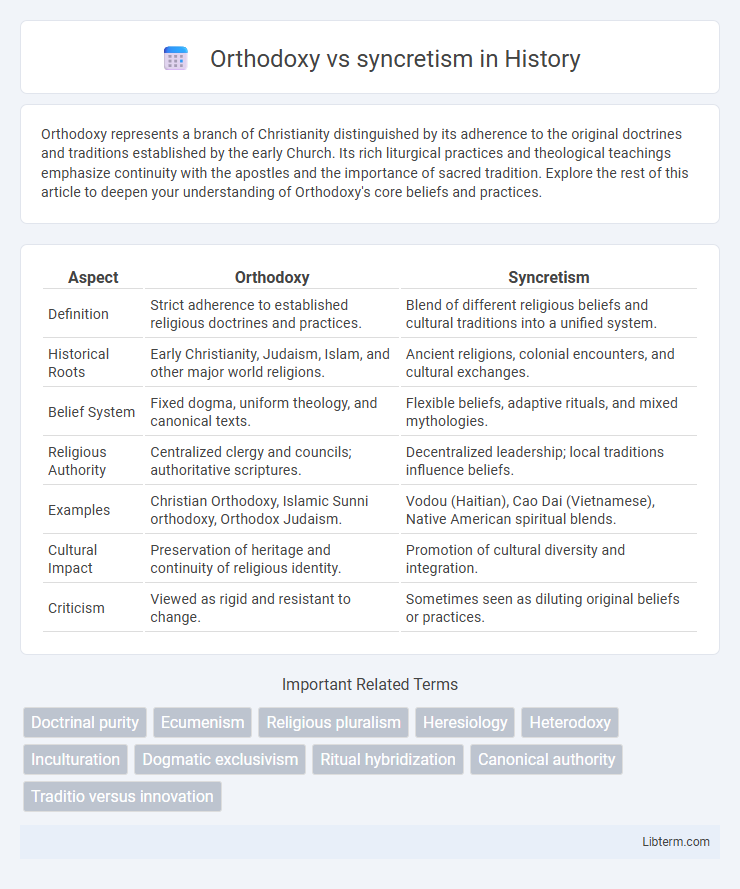Orthodoxy represents a branch of Christianity distinguished by its adherence to the original doctrines and traditions established by the early Church. Its rich liturgical practices and theological teachings emphasize continuity with the apostles and the importance of sacred tradition. Explore the rest of this article to deepen your understanding of Orthodoxy's core beliefs and practices.
Table of Comparison
| Aspect | Orthodoxy | Syncretism |
|---|---|---|
| Definition | Strict adherence to established religious doctrines and practices. | Blend of different religious beliefs and cultural traditions into a unified system. |
| Historical Roots | Early Christianity, Judaism, Islam, and other major world religions. | Ancient religions, colonial encounters, and cultural exchanges. |
| Belief System | Fixed dogma, uniform theology, and canonical texts. | Flexible beliefs, adaptive rituals, and mixed mythologies. |
| Religious Authority | Centralized clergy and councils; authoritative scriptures. | Decentralized leadership; local traditions influence beliefs. |
| Examples | Christian Orthodoxy, Islamic Sunni orthodoxy, Orthodox Judaism. | Vodou (Haitian), Cao Dai (Vietnamese), Native American spiritual blends. |
| Cultural Impact | Preservation of heritage and continuity of religious identity. | Promotion of cultural diversity and integration. |
| Criticism | Viewed as rigid and resistant to change. | Sometimes seen as diluting original beliefs or practices. |
Defining Orthodoxy: Core Tenets and Beliefs
Orthodoxy centers on adherence to established doctrines and unchanging core tenets such as the divinity of Christ, the authority of sacred scriptures, and the necessity of sacraments for salvation. It emphasizes maintaining doctrinal purity and resisting syncretism, which blends diverse religious beliefs and undermines foundational truths. This commitment to traditional beliefs is essential for preserving the identity and unity of the faith community.
Syncretism Explained: Blending Traditions and Ideas
Syncretism involves the merging of different religious, cultural, or philosophical traditions into a unified system, often blending beliefs and practices from diverse sources. This process contrasts with Orthodoxy, which emphasizes maintaining established doctrines and resisting changes that alter core teachings. Syncretism can lead to new spiritual expressions but may challenge the purity and integrity upheld by orthodox communities.
Historical Roots of Orthodoxy and Syncretism
Orthodoxy traces its historical roots to early Christianity, emphasizing preservation of apostolic teachings and doctrinal purity as established by the Ecumenical Councils between the 4th and 8th centuries. Syncretism, by contrast, emerges from cultural exchanges where religious beliefs and practices from different traditions blend, evident in regions influenced by Hellenistic, Roman, and indigenous religions. The tension arises as Orthodoxy prioritizes continuity and authoritative scripture, while syncretism reflects adaptability and fusion within evolving spiritual landscapes.
Orthodoxy in Major World Religions
Orthodoxy in major world religions emphasizes adherence to established doctrines, rituals, and beliefs that preserve the original teachings and practices of faith traditions such as Christianity, Islam, and Judaism. This strict conformity ensures theological consistency and communal identity, distinguishing orthodox followers from syncretic movements that blend various religious or cultural elements. Orthodoxy upholds sacred texts and authoritative interpretations, which resist syncretism's incorporation of external influences and innovations.
Syncretism Across Cultures and Eras
Syncretism occurs when distinct religious or cultural beliefs merge, creating hybrid traditions that blend elements from multiple origins. This phenomenon appears across cultures and eras, such as the fusion of indigenous American rituals with Christianity during colonial times or the integration of Hellenistic philosophy into early Christian theology. Understanding syncretism reveals how communities adapt and transform orthodox doctrines to reflect evolving social and spiritual identities.
Key Differences: Purity vs Adaptation
Orthodoxy emphasizes doctrinal purity, maintaining established beliefs and practices without alteration to preserve theological integrity. Syncretism embraces adaptation by blending elements from different religious traditions, creating hybrid practices that reflect cultural diversity. The key difference lies in orthodoxy's commitment to unchanging truth versus syncretism's flexible integration to foster inclusivity.
Benefits and Challenges of Orthodoxy
Orthodoxy offers the benefit of preserving doctrinal purity and providing a clear, consistent framework for faith and practice, which fosters strong community identity and stability. Adherence to established beliefs can enhance spiritual discipline and continuity across generations, ensuring the transmission of core teachings without dilution. However, challenges include resistance to cultural adaptations and difficulty engaging with diverse contemporary perspectives, which may limit outreach and relevance in pluralistic societies.
Advantages and Risks of Syncretism
Syncretism fosters cultural exchange and religious inclusivity, enabling the blending of diverse spiritual traditions that can promote peace and mutual understanding. This approach allows adaptability and evolution of beliefs, appealing to broader communities and addressing contemporary spiritual needs. However, syncretism risks diluting core doctrines, causing theological confusion and potential loss of identity within established faiths, which Orthodox adherents often view as compromising authentic teachings.
Modern Examples: Orthodoxy and Syncretism in Practice
Modern examples of orthodoxy include strict adherence to canonical Christian doctrines by the Russian Orthodox Church, emphasizing liturgical tradition and theological consistency. Syncretism is evident in movements like the New Age, which blend elements from Christianity, Eastern spirituality, and indigenous beliefs, creating hybrid religious practices. Orthodox communities often resist syncretic trends to preserve doctrinal purity, while syncretic groups prioritize spiritual inclusivity and adaptability in contemporary contexts.
The Ongoing Debate: Future of Faith and Cultural Identity
Orthodoxy maintains strict adherence to established doctrines, preserving religious purity and cultural heritage, while syncretism blends diverse beliefs, fostering adaptability and inclusivity. This ongoing debate centers on whether faith communities should prioritize doctrinal integrity or embrace evolving cultural identities. The future of religious identity hinges on balancing tradition with societal change, influencing both spiritual continuity and cultural cohesion.
Orthodoxy Infographic

 libterm.com
libterm.com